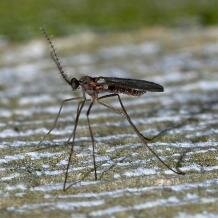Topic: Agriculture in gall midges (Diptera)
Flies, fungi, farming - sounds interesting? Read on if you want to learn about some rather different gall midges...
 The larvae of gall midges (Cecidomyiidae) are probably best known for inducing abnormal plant growths called galls, often causing economic damage. Normally during gall formation, plant cells are activated, partial cell breakdown occurs and nutritive tissue, which is of crucial importance for the development of the larva, differentiates. However, two tribes of gall midges, the Lasiopterini and the Asphondyliini, produce a different type of gall, the so-called ‘ambrosia galls’. If this term reminds you of the fungus-farming ambrosia beetles, this is no coincidence – the ambrosia galls do indeed contain the mycelium of a symbiotic fungus.
The larvae of gall midges (Cecidomyiidae) are probably best known for inducing abnormal plant growths called galls, often causing economic damage. Normally during gall formation, plant cells are activated, partial cell breakdown occurs and nutritive tissue, which is of crucial importance for the development of the larva, differentiates. However, two tribes of gall midges, the Lasiopterini and the Asphondyliini, produce a different type of gall, the so-called ‘ambrosia galls’. If this term reminds you of the fungus-farming ambrosia beetles, this is no coincidence – the ambrosia galls do indeed contain the mycelium of a symbiotic fungus.
 In many cases, a particular species of gall midge is associated with a certain fungus. Galls induced by Asphondylia, for example, contain Macrophoma fungi, whereas the galls of Lasioptera arundinis on a particular reed (Phragmites australis) are inoculated with Ramichloridium subulatum. The association between Lasioptera and Ramichloridium is relatively well studied. After emergence, female midges collect fungal conidia (asexual, non-motile spores), which are placed into specialised abdominal pouches reminiscent of the mycangia of ambrosia beetles. On oviposition, the conidia are injected into the reed stem along with the eggs. Once hatched, the larvae lacerate the plant tissue with their mandibles, thus allowing fungal attack, and then follow the growing mycelium, finally invading the plant’s innermost vascular tissues. The larvae consume a complex consisting of protein-rich fungal hyphae and plant cells, which ‘mimics’ the nutritive tissue induced by the more typical gall midges. Obviously, this insect-fungus relationship is a true mutualism. The fungus, which could not invade the plant on its own, enables the larva to tap the plant’s vascular tissues and induce plant cell activation, in addition to providing a nutritious food source.
In many cases, a particular species of gall midge is associated with a certain fungus. Galls induced by Asphondylia, for example, contain Macrophoma fungi, whereas the galls of Lasioptera arundinis on a particular reed (Phragmites australis) are inoculated with Ramichloridium subulatum. The association between Lasioptera and Ramichloridium is relatively well studied. After emergence, female midges collect fungal conidia (asexual, non-motile spores), which are placed into specialised abdominal pouches reminiscent of the mycangia of ambrosia beetles. On oviposition, the conidia are injected into the reed stem along with the eggs. Once hatched, the larvae lacerate the plant tissue with their mandibles, thus allowing fungal attack, and then follow the growing mycelium, finally invading the plant’s innermost vascular tissues. The larvae consume a complex consisting of protein-rich fungal hyphae and plant cells, which ‘mimics’ the nutritive tissue induced by the more typical gall midges. Obviously, this insect-fungus relationship is a true mutualism. The fungus, which could not invade the plant on its own, enables the larva to tap the plant’s vascular tissues and induce plant cell activation, in addition to providing a nutritious food source.
Fungus acquisition and deposition by Asphondyliini used to be less well known, but recent observations have now revealed very similar mechanisms. However, it is considered likely that the intimate associations of Lasiopterini and Asphondyliini gall midges with fungi have evolved via different pathways in the two tribes. Not only do they attack different plant organs, employing different fungal symbionts and different strategies for accessing plant nutrients, but they also differ in the morphology of their ovipositors and ‘mycangial’ pouches.
 Recently, a gall midge species in the tribe Alycaulini, Asteromyia carbonifera, has also been shown to form a close association with a fungus, Botryosphaeria dothidea. Populations of this insect induce galls on a wide range of goldenrod species (Solidago) and often show host-associated genetic differentiation. On late goldenrod (S. altissima), four genetically distinct morphotypes of galls that are mainly formed of fungal mycelium have been described, suggesting adaptive radiation of the insect on this particular host. It has been suggested that the interactions with the fungus have played a role in this diversification. In contrast to the obligate mutualisms described above, Botryosphaeria, albeit possibly benefiting from dispersal by Asteromyia, is most likely able to exist in other environments. The midge larvae, on the other hand, strongly depend on the fungus for the successful production of galls and for food (it seems that they do not have direct access to plant tissues, as they are enveloped by the fungal mycelium).
Recently, a gall midge species in the tribe Alycaulini, Asteromyia carbonifera, has also been shown to form a close association with a fungus, Botryosphaeria dothidea. Populations of this insect induce galls on a wide range of goldenrod species (Solidago) and often show host-associated genetic differentiation. On late goldenrod (S. altissima), four genetically distinct morphotypes of galls that are mainly formed of fungal mycelium have been described, suggesting adaptive radiation of the insect on this particular host. It has been suggested that the interactions with the fungus have played a role in this diversification. In contrast to the obligate mutualisms described above, Botryosphaeria, albeit possibly benefiting from dispersal by Asteromyia, is most likely able to exist in other environments. The midge larvae, on the other hand, strongly depend on the fungus for the successful production of galls and for food (it seems that they do not have direct access to plant tissues, as they are enveloped by the fungal mycelium).
Cite this web page
Map of Life - "Agriculture in gall midges (Diptera)"
https://mapoflife.org/topics/topic_470_agriculture-in-gall-midges-diptera/
November 29, 2020

